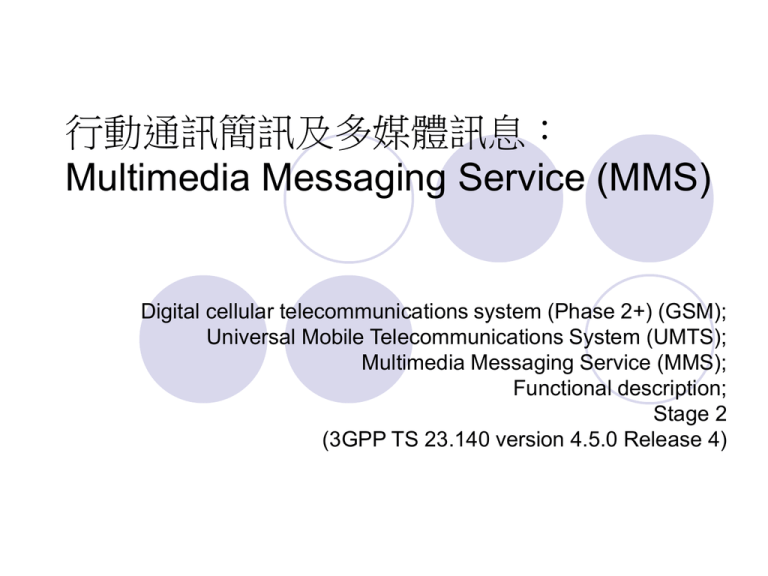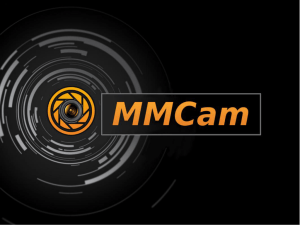MMS Relay/Server A
advertisement

行動通訊簡訊及多媒體訊息: Multimedia Messaging Service (MMS) Digital cellular telecommunications system (Phase 2+) (GSM); Universal Mobile Telecommunications System (UMTS); Multimedia Messaging Service (MMS); Functional description; Stage 2 (3GPP TS 23.140 version 4.5.0 Release 4) Chapter 4 General Architecture Overview It combines different networks and network types and integrate messaging systems. It comprise 2G and 3G networks, 3G networks with islands of coverage within a 2G network and roamed networks. MMES: Multimedia Messaging Service Environment。 MMS Architectural Elements The basis of connectivity between these different networks shall be provided by the Internet protocol and its associated set of messaging protocols. MMSNA: Multimedia Messaging Service Network Architecture MMSE :a collection of MMS-specific network elements under the control of a single administration. MMS relay/Server storage and handling of incoming and outgoing messages and for the transfer of messages between different messaging systems. distribute across different domains. be able to generate charging data (Call Data Record - CDR) MMS User Databases: contain user related information such as subscription and configuration (e.g. user profile, HLR). MMS User Agent: It is an application layer function that provides the users with the ability to view, compose and handle MMs (e.g. submitting, receiving, deleting of MMs). MMS VAS Applications: offer Value Added Services to MMS users and be able to generate CDRs. External Server: an external system such as Internet email, messaging system or facsimile. Protocol Framework provide flexibility, integration of existing and new services together with interoperability across different networks and terminals。 In this framework, This MMS Relay/Server may provide convergence functionality between External Servers and MMS User Agents and enables the integration of different server types across different networks. the MM1 transfer protocol using WAP or applications conforming to MExE (e.g. Java and TCP/IP)。 MExE: Mobile Execution Environment Addressing MMS supports E-Mail addresses (RFC 822) or MSISDN . MMS supports address hiding ,i.e. anonymous messages. each MMSE should be assigned a unique domain name. The usage of MSISDN is to address a recipient in a different MMS service provider's domain . Chapter 5 Functional Description of Involved MMS Elements MMS User Agent operations The User Agent shall provide application layer functionalities : -the retrieval of MMs. additional application layer functionalities: - the MM composition - the MM submission - the MM presentation; - the presentation of notifications to the user - the signing of an MM on an end-user to end-user basis. - the decryption and encryption of an MM on an end-user to end-user basis. - all aspects of storing MMs on the terminal. - the handling of external devices. - the user profile management. Minimum set of supported formats Multiple media elements shall be combined into a composite single MM using MIME multipart format. Text Any character encodeing (charset) that contains a subset of characters in Unicode shall be used. Speech MMS User Agents supporting media type Speech shall support AMR Still Image MMS User Agents supporting media type Image shall support Baseline JPEG. Video In order to alignment with the codes specified for Packet Switched Streaming Services , ITU-T H.263 baseline shall be supported. File Format for dynamic media for the transport of video and speech/audio in an MM, the MP4 file format shall be supported. Additional suggested codes Media type Audio: MP3 MIDI AAC Media type Image: GIF 89a Media type Video: MPEG-4 Visual Simple Profile Level 0 H.263 profile 3 level 10 MMS Relay/Server responsible for storage and handling of messages. provide convergence functionality between External Servers and MMS User Agents and enable the integration of different server types across different networks. responsible for functions receiving and sending MM; enabling/disabling MMS function; personalizing MMS based on user profile information; MM deletion based on user profile or filtering information; media type conversion; media format conversion; conversion of messages arriving at the recipient MMS Relay/Server from legacy messaging systems to MM format. (e.g. facsimile to MM) conversion of MMs leaving the originator MMS Relay/Server to legacy messaging systems to the appropriate message format. (e.g. MM to internet email) message content retrieval; MM forwarding; screening of MM; negotiation of terminal capabilities; checking terminal availability; MM notification to the MMS User Agent; generating call data records (CDR); address translation. address hiding managing the message properties on servers (e.g. voicemail or email server) integrated in the MMSE (consistency) temporary and/or persistent storage of messages ensuring that messages are not lost until successfully delivered to another MMSE element controlling the reply-charging feature of MMS External Servers Several External Servers may be included within or connected to an MMSE, e.g. E-Mail Server, SMS Server (SMSC) ,Fax. MMS User Databases and HLR User Databases shall provide -MMS user subscription information; -information for the control of access to MMS; -information for the control of the extent service capability (e.g. server storage space); -a set of rules how to handle incoming messages and their delivery; -information of the current capabilities of the users terminal. MMS VAS Applications Applications provide value added services to the MMS users. provide additional features like MM recall between MMS VAS Applications and MMS Relay/Server which are not available for MMS User Agents. be able to generate CDRs . Chapter 6 MMS Service Behaviour Description Submission of a MM in the originator MMSE When a user send an MM to several destinations ,the MM shall be submitted to the originator MMS Relay/Server. the MMS User Agent of supporting submission shall be able to: ‧ Indicate the address of the MM recipient ‧ Identify the MIME content type of the message. ‧ Request a delivery report for the message ‧ Request a read-reply report for the message ‧ Provide a time stamp for the time of submission of the message ‧ Set the earliest desired time of delivery for the message ‧ Set the desired time of expiry for the message ‧ Indicate the address of the MM originator ‧ Set further message qualifications (e.g. priority, message class, subject) ‧ Request the MM originator's address being hidden from the recipient MMS User Agent. reception of an MM from originator MMS User Agent the originator MMS Relay/Server shall ‧assign a Message Identification to MM and immediately provide the originator MMS User Agent with it . ‧for retaining the MM until the earliest desired time of delivery. ‧provide a time stamp. ‧insert the originator's address into the MM if not yet provided by the originator MMS User Agent. ‧pass the originator's address to the peer entity known to be a MMS Relay/Server. ‧not pass the originator's address if addressing is requested and the peer entity is not known to MMS server. ‧ resolving the MM recipient's address. ‧ route the MM towards the MM recipients. ‧ pass the indication whether a delivery or a read-reply report is requested. ‧pass the indication about MIME content type of the message and message qualifications (e.g. priority,message class, subject). ‧ generate a delivery report indicating "indeterminate" status of the delivery. Reception of a Multimedia Message in the recipient MMSE Upon reception of an MM ,the recipient MMS Relay/Server shall ‧ may verify the MM recipient's user profile. ‧ shall store the MM at least until 1.the associated time of expiry is reached. 2.the MM is delivered, 3.the recipient MMS User Agent requests MM to be routed forward or rejected. ‧generate a notification to the recipient User Agent. Multimedia Message Notification the recipient MMS Relay/Server shall not include the originator address into the MM notification if requesting address hiding. In a response to the notification the MMS User Agent shall be able to ‧ reject the MM, ‧ retrieve the MM, either immediately or at a later time, either manually or automatically, determined by configuration and user profile. Retrieval of a Multimedia Message in the recipient MMSE Upon delivery request, the recipient MMS Relay/Server shall ‧deliver the MM to the recipient MMS User Agent. ‧perform data adaptation based on user profile capabilities. ‧not provide the MM originator address if requesting address hiding. ‧provide an alias or clarifying text (e.g. "anonymous address" or "unknown address "). ‧give delivery or reply-read report to the recipient if requesting. ‧indicate the MIME content type. ‧provide available message qualifications. ‧provide the time stamp of the MM. ‧storage of messages until reaching the recipient MMS User Agent . ‧provide a list of addresses of forwarding MMS User Agents. Forwarding of a Multimedia Message without prior Retrieval If supporting and requesting MM forwarding ,the MMS User Agent shall ‧ indicate the address of MM recipients. ‧ provide the message reference provided in MM Notification ‧ not generate a read-reply report to the originator MMS User Agent even if being requested. If supporting requesting forwarding of MM, the forwarding MMS User Agent may ‧Indicate the address of the Forwarding MMS User Agent (i.e. it's own address). ‧Provide the time of submission stamp. ‧Set the desired time of expiry. ‧ Set the earliest desired time of delivery. ‧ Request a delivery and reply-read report. Upon reception of a request to forward an MM, the forwarding MMS Relay/Server shall be the same whit MMS Relay/Server. Delivery Report If be requested or not, the recipient MMS Relay/Server shall ‧generate the delivery report and deliver it to the originator MMS Relay/Server. ‧storage of delivery reports until the originator MMS Relay/Server becomes reachable or until the delivery report expires. Within the delivery report, the recipient MMS Relay/Server shall ‧provide the MM originator and recipient address to the originator MMS Relay/Server. ‧provide status information how the MM was handled (e.g. expired, rejected, delivered, forwarded or indeterminate) to the originator MMS Relay/Server. ‧provide the identification to the originator MMS Relay/Server. ‧provide a time stamp when the MM was handled to the originator MMS Relay/Server. Within the delivery report, the originator MMS Relay/Server shall ‧provide the MM recipient's address to the originator MMS User Agent. ‧provide the identification of MM. ‧storage of delivery reports until the originator MMS Relay/Server becomes reachable or until the delivery report expires. Read-Reply Report A read-reply report: ‧contain the MM originator's and recipient's address. ‧contain the message identification of the original MM. ‧ shall provide status how to be rendered (e.g. read, deleted without being read). ‧shall provide a time stamp. Upon reception of a read-reply report from a recipient MMS User Agent ,the recipient MMS Relay/Server shall ‧provide a time stamp for this report. ‧ pass the MM originator address. ‧insert the MM recipient's address to this report. ‧resolve the MM originator's address. ‧route the read-reply report to the originator MMS User Agent. Support for Streaming in MMS MM contents may be either delivered as non-streaming MM elements, or made available for streaming retrieval. to decides whether to use streaming based on the media type and format ,capability negotiation or user settings . streaming is It is optional support. Support for Prepaid Service in MMS In the submission case 1.first ascertain that the originator of the MM is a prepaid customer. 2.initiate a credit check, if the customers credit is insufficient, MMS Relay/Server may reject it. 3.processing of the MM message. In the retrieving case. It is the same with the submission case. Support for Reply-Charging in MMS The request for reply-charging shall not be passed on to the recipient ‧ if the recipient is not known to belong to an MMSE peer entity. ‧ in the case the MM is forwarded. NOTE: ‧Support for reply-charging in MMS is restricted to MMS User Agents belonging to the same MMSE. ‧allows only one reply-MM per recipient. ‧a reply-MM is restricted to text only. the MM originator may indicate a willingness to pay the charge for one replyMM per MM recipient. the originator MMS User Agent ‧indicate the sender's willingness to pay the charge for one reply-MM per MM recipient, ‧ may define a reply-charging limitation request (e.g. may specify the latest time of submission of the reply-MMs or a maximum size of reply-MMs). In a response to the MM submission ,the originator MMS Relay/Server shall inform the originator MMS User Agent whether it accepts ‧the originator's request for reply-charging in the original MM. ‧ the reply-charging limitations set by the originator MMS User Agent Upon reception of an MM from an originator MMS User Agent, the originator MMS Relay/Server ‧ may provide reply-charging limitations. ‧shall pass the indication whether or not a reply-MM is requested when routing. ‧pass the reply-charging limitations for the reply-MM. If reply-charging has been requested by the MM originator ,the recipient MMS Relay/Server ‧ inform the recipient MMS User Agent with the MM notification ‧ may notify the recipient about the replycharging limitations set by the orginator When a user intends to send a reply-MM to the MM originator. the recipient MMS User Agent ‧mark the MM as a reply-MM, ‧provide the message-ID of the original MM), ‧submit the reply-MM to the recipient MMS Relay/Server, ‧ indicate whether this MM has already been replied to, ‧ indicate if the reply-charging limitations can not be met. Upon submission, the recipient MMS Relay/Server shall ‧ reject the reply-MM and should convey this information back to the recipient MMS User Agent if not meeting the limitations set by the originator MMS User Agent, ‧uniquely map the reply-MM to the original MM. MMSE Addressing responsibilities Address parsing: MMS Relay/Server should parse the recipient address provided by the originator MMS User Agent. Locating the recipient: resolve whether the recipient belongs to the same MMSE, another MMSE or is not known to belong to any MMSE. If the recipient belongs to the same MMSE ,the MMS Relay/Server shall notify the recipient of MM. If belonging to another MMSE, the MMS Relay/Server has to locate the external recipient's MMSE domain. If the recipient is not known to belong to any MMSE, the MMS Relay/Server shall perform the conversion and route forward the message to the recipient. Address Formats on MM4 Resolving the recipient's MMSE IP address: resolve MMS Relay/Server domain name to an IP address. Re-formatting the sender's an recipient's address to FQDN format delivering a message from an MMSE to another, both the sender and recipient addresses shall include the FQDN to enable transport over SMTP. Address Formats on MM1 addressing model on MM1 contains three addresses: the address of the MMS Relay/Server, the address of the recipient and the address of the originator. The address of the MMS Relay/Server shall be the URI. URI: Uniform Resource Identifiers. MMS Reference Architecture MMS User Databases HLR MM6 MMS User Agent A “Foreign” MMS Relay/Server MM1 MMS User Agent B MMS VAS Applications MM5 MM7 MM1 MMS Relay/Server Relay MM4 MM2 Server MM3 External Server #1 (e.g. E-Mail) External Server #2 (e.g. Fax) External Server #3 (e.g. UMS) ... External Server #N MMSE Interfaces MM1: MMS Relay/Server – MMS User Agent Submit Multimedia Messages from MMS User Agent to MMS Relay/Server. Exchange notification and delivery reports. MM3: MMS Relay/Server – External Servers MMS Relay/Server use MM3 to send Multimedia Messages and retrieve MMs from servers of external messaging systems. These external messaging systems are connected to the service provider's MMS Relay/Server. MMSE Interfaces MM4: Interworking of different MMSEs MMS User Agent A MMSE MMSE Service Provider A Service Provider B Radio Network B Radio Network A MM1 MMS User Agent B MMS Relay/Server A SMTP MMS Relay/Server B MM4 Interworking of different MMSEs MM1 MMSE Interfaces MM5: MMS Relay/Server – HLR provide information to the MMS Relay/Server about the subscriber. it shall use existing MAP operations e.g. procedures for determining the location of the mobile, procedures for alerting SMS service centers. MM6: MMS Relay/Server – MMS User Databases MMSE Interfaces MM7: MMS Relay/Server – MMS VAS Applications Transfer MMs between MMS Relay/Server and MMS VAS application. News service Weather forecast This reference point shall be based on existing protocols e.g. SMTP or HTTP The labelling of the MMS abstract messages the transactions between the MMS UA and MMS Relay/Server are prefixed with "MM1"; the transactions between the MMS Relay/Servers are prefixed with "MM4"; requests are identified with ".REQ" as a suffix; responses are identified with the"“.RES" suffix. Example Abstract Message Flow Submission of Multimedia Message For sending purposes the originator MMS User Agent shall submit a terminal-originated MM to the originator MMS Relay/Server using the MM1_submit.REQ MMS control information MM content The MMS Relay/Server shall respond with an MM1_submit.RES provides the status of the request The MM1_submit.RES shall unambiguously refer to the corresponding MM1_submit.REQ. Information elements in the MM1_submit.REQ. Information elements in the MM1_submit.REQ. Information elements in the MM1_submit.RES. Multimedia Message Notification This part covers the notification about MM from the recipient MMS Relay/Server to the recipient MMS UA. The recipient MMS User Agent may indicate in the MM1_notification.RES how it intends the MM to be handled, e.g. the immediate rejection of the MM. Information elements in the MM1_notification.REQ. Information elements in the MM1_notification.RES. Retrieval of Multimedia Message The recipient MMS User Agent shall issue an MM1_retrieve.REQ to the recipient MMS Relay/Server to initiate the retrieval process. The MMS Relay/Server shall respond with an MM1_retrieve.RES MMs control information MM content. The recipient MMS User Agent shall send an MM1_acknowledgement.REQ to the corresponding MMS Relay/Server, if requested by the MMS Relay/Server. Information elements in the MM1_retrieve.REQ Message Reference: The recipient MMS User Agent shall always provide a reference, e.g., URI, for the MM in the MM1_retrieve.REQ. Information elements in the MM1_retrieve.RES Information elements in the MM1_retrieve.RES Information elements in the MM1_acknowledgement.REQ Forwarding of Multimedia Message The forwarding MMS User Agent shall issue an MM1_forward.REQ to the forwarding MMS Relay/Server, which contains MMS control information. The address(es) of other recipients shall be specified by the forwarding MMS User Agent. Information elements in the MM1_forward.REQ. Information elements in the MM1_forward.RES. Delivery Report Delivery Report: feedback information provided to an originator MMS User Agent by an MMS Relay/Server about the status of the delivery of an MM e.g. retrieved, forwarded, rejected, expired or indeterminate. Information elements in the MM1_delivery_report.REQ. Read-Reply Report Read-Reply Report: feedback information to an originator MMS User Agent by a recipient MMS User Agent about the status of handling/rendering of an original MM in a recipient MMS User Agent e.g. Read, Deleted without being read Information elements in the MM1_read_reply_recipient.REQ. Information elements in the MM1_read_reply_originator.REQ. Technical realisation of MMS on reference point MM3 This clause defines the interworking between MMS Relay/Servers and External Servers. Reference point MM3 should be based upon existing standards e.g. HTTP, SMTP. Technical realisation of MMS on reference point MM3 Sending of MMs the originator MMS Relay/Server should convert the MM into a format appropriate for the external messaging system. Receiving of messages the recipient MMS Relay/Server should convert incoming messages to the MM format in use by the recipient(s) Discovery of new messages on External Servers Forwarding of messages from External Server to MMS Relay/Server, based on criteria defined by the user or application; Notification of messages from an External Server, followed by retrieval by the MMS User Agent via the MMS Relay/Server; periodic polling for messages on External Server, followed by retrieval by the MMS User Agent via the MMS Relay/Server. Routing Forward of a Multimedia Message This clause defines the interworking between MMS Relay/Servers once the peer systems are aware of each other being an MMSE. After successful discovery of its peer entity the originator MMS Relay/Server shall route an MM forward to the recipient MMS Relay/Server using the MM4_forward.REQ MMS control information, the MM content. Information elements in the MM4_forward.REQ. Information elements in the MM4_forward.REQ. Information elements in the MM4_forward.REQ. Information elements in the MM4_forward.RES. Routing Forward of a Delivery Report the recipient MMS Relay/Server shall route a previously created delivery report forward to the originator MMS Relay/Server using the MM4_delivery_report.REQ contains MMS control information only. Information elements in the MM4_delivery_report.REQ. Information elements in the MM4_delivery_report.RES. Routing Forward of a Read-Reply Report The recipient MMS Relay/Server shall route a read-reply report forward, to the originator MMS Relay/Server using the MM4_read_reply_report.REQ contains MMS control information only. Information elements in the MM4_read_reply_report.REQ. Information elements in the MM4_read_reply_report.RES. Message format on MM4 All elements of an MM shall be included within a single SMTP "mail" message All MM elements shall be of standard MIME content types. MMS information elements should be reflected as "header fields" according to STD 11 in the SMTP "mail" message. MM4_Forward.REQ Header Mappings MM4_Forward.RES Header Mappings MM4_Delivery_report.REQ Header Mappings MM4_Delivery_report.RES Header Mappings MM4_Read_reply_report.REQ Header Mappings MM4_Read_reply_report.RES Header Mappings Example of combined MMSRelay/Server This scenario shows the case where the two logical entities, MMS Relay and MMS Server, are combined into a single physical entity. Example of non-combined MMS-Relay and MMS-Server Example of MMS interaction with T.30 Facsimile Services Example of MMS interaction with 2G/3G Voice Mailboxes Example of interaction with Internet EMail Messaging Example of interaction with Short Message Service, SMS Protocol Framework Scope of WAP Support for MMS WSP: WAP Session Protocol Transaction Flows Supporting MMS ‧MMS User Agent originates MM ‧MMS Relay/Server notification to an MMS User Agent about an available MM; ‧MMS User Agent retrieving MM; ‧MMS User Agent support for retrieval acknowledgement to MMS Relay/Server; ‧MMS Relay/Server sending delivery report to MMS User Agent. MMS Transactional Flow in WAP WSP/HTTP POST METHOD WSP/HTTP GET METHOD Terminal Capability Negotiation WAP provides a mechanism to inform server, such as the MMS Relay/Server, of the capabilities of the MMS User Agent. known for User Agent Profile (UAProf). UAProf provides information about the characteristics of the display (e.g. size, color support, bit depth), supported content types and network limitations MMS Relay/Server should be able to utilize the capability information (UAProf) to make adjustments to the delivered MM contents. IP Based Implementation of MMS for future releases Protocol Framework IP Based Implementation transaction flows for IP Based Implementation




